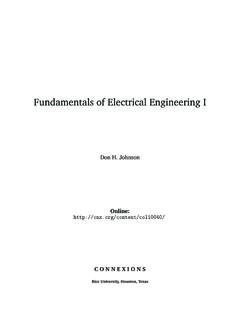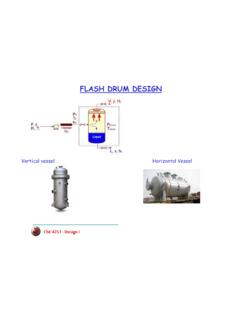Transcription of Experiment 6 Transistors as amplifiers and switches
1 Introductory Electronics Laboratory 6- i Experiment 6 Transistors as amplifiers and switches Our final topic of the term is an introduction to the transistor as a discrete circuit element. Since an integrated circuit is constructed primarily from dozens to even millions of Transistors formed from a single, thin silicon crystal, it might be interesting and instructive to spend a bit of time building some simple circuits directly from these fascinating devices. We start with an elementary description of how a particular type of transistor, the bipolar junction transistor (or BJT) works. Although nearly all modern digital ICs use a completely different type of transistor, the metal-oxide-semiconductor field effect transistor (MOSFET), most of the Transistors in even modern analog ICs are still BJTs. With a basic understanding of the BJT in hand, we design simple amplifiers using this device.
2 We spend a bit of time studying how to properly bias the transistor and how to calculate a transistor amplifier s gain and input and output impedances. Following our study of amplifiers , we turn to the use of the BJT as a switch, a fundamental element of a digital logic circuit. Single transistor switches are useful as a way to interface a relatively low-power op-amp comparator output to a high-current or high-voltage device. These switches are also very useful to translate the output of an op-amp comparator to the proper 1 and 0 voltage levels of a standard digital logic circuit input. The final section of the text presents a few additional useful transistor applications including a discussion of a differential amplifier and a basic Class B power amplifier stage, both of which represent common building blocks of the operational amplifier. Experiment 6 6- ii Copyright Frank Rice 2013 2019 Pasadena, CA, USA All rights reserved.
3 Introductory Electronics Laboratory 6- iii CONTENTS TABLE OF CIRCUITS 6-IV THE BIPOLAR JUNCTION TRANSISTOR 6-1 What is a transistor and how does it work? .. 6-1 The relationship between the base and collector currents: (hfe) .. 6-3 The transistor as an amplifier .. 6-4 BASIC TRANSISTOR AMPLIFIER DESIGN 6-7 Designing a common-emitter amplifier stage .. 6-7 High gain amplifiers : the dynamic emitter resistance re .. 6-11 Simple high-gain amplifier stage .. 6-12 TRANSISTOR SWITCH CIRCUITS 6-14 The transistor as a switch .. 6-14 Basic switching circuits .. 6-15 Generating digital logic levels from analog signals; simple logic circuits .. 6-17 Simple logic operations using transistor switches .. 6-18 PRELAB EXERCISES 6-19 LAB PROCEDURE 6-20 Common-emitter amplifier .. 6-20 Adding an emitter follower output stage .. 6-20 High-gain amplifier .. 6-21 Transistor switch .. 6-22 Additional circuits .. 6-22 Lab results write-up.
4 6-22 MORE CIRCUIT IDEAS 6-23 Phase Splitter .. 6-23 Using PNP Transistors .. 6-23 A differential amplifier stage .. 6-24 Boosting op-amp output power .. 6-27 Experiment 6 6- iv TABLE OF CIRCUITS Basic transistor logic gate implementations 6- 18 Comparator output to logic-level translation 6- 17 Differential amplifier circuit, DC coupled 6- 24 Transistor amplifier with emitter follower output 6- 21 Transistor common emitter amplifier 6- 7 Transistor high-gain amplifier 6- 12 Transistor op-amp current booster output stage 6- 27 Transistor phase splitter 6- 23 Transistor PNP circuit configurations 6- 23 Transistor switch, NPN 6- 14, 6-15 Introductory Electronics Laboratory 6- 1 THE BIPOLAR JUNCTION TRANSISTOR What is a transistor and how does it work? The bipolar junction transistor (or BJT) was invented at Bell Laboratories by William Shockley in 1948, the year after he, John Bardeen, and Walter Brattain invented the first working transistor (for which they were awarded the 1956 Nobel Prize in physics).
5 It is constructed from a sandwich of three layers of doped semiconductor material, the thin middle layer being doped oppositely from the other two. Thus there exist two types of BJT: NPN and the PNP, whose schematic symbols are shown at right. The three layers are called the emitter, base, and collector, and their identification with the three schematic device terminals is also illustrated in the figure (note that the emitter is associated with the arrow in the schematic symbols). The base is the thin middle layer, and it forms one PN junction with the heavily-doped emitter and another with the lightly-doped collector. When used as an amplifier, the base-emitter junction is forward-biased, Figure 6-1: The inner workings of an NPN bipolar junction transistor. This transistor may be thought of as a sandwich of a thin P-type semiconductor layer (the base) between two N-type layers (the emitter and the collector).
6 The emitter is very heavily doped with N-type charge carriers (conduction electrons). When the base-emitter PN junction is forward biased current flows from the base to the emitter. Because the base is very thin and the emitter is heavily doped, most of the emitter s charge carriers (electrons) which diffuse into the PN junction continue right on through it and into the collector. This results in a current flow from collector to emitter which can be much larger than the current flow from base to emitter. EmitterBaseCollectorBICIEBCI II= +EmitterBaseCollectorElectron flowNPNPNP eebbccExperiment 6: The bipolar junction transistor 6- 2 whereas the collector-base junction is reverse-biased (in the case of an NPN transistor, the collector would be at the most positive voltage and the emitter at the most negative). The resultant charge carrier flows within the NPN transistor are illustrated in Figure 6-1.
7 Consider an NPN transistor s behavior as shown in Figure 6- 1. When the base-emitter PN junction is forward-biased, a current flows into the base and out of the emitter, because this pair of terminals behaves like a typical PN junction semiconductor diode. The voltage drop from base to emitter is thus that of a typical semiconductor diode, or about (nearly all Transistors use silicon as their semiconductor). If the collector s potential is set more than a few 1/10ths of a volt higher than that of the base, however, an interesting effect occurs: nearly all of the majority charge carriers from the emitter which enter the base continue right on through it and into the collector! The electrons from the N-type emitter that enter the base then diffuse around randomly in the P-type base s semiconductor material. Because the base is thin and the emitter has a large concentration of charge carriers (it is heavily doped), many electrons from the emitter approach the collector-base PN junction before they have a chance to recombine with the much smaller concentration of base charge carriers (holes in the case of an NPN transistor).
8 The external bias voltage applied to the collector will then accelerate these emitter charge carriers across the collector-base PN junction. Consequently, most of the emitter charge carriers crossing the forward-biased base-emitter junction enter the collector, where they intermingle with the collector s lower concentration of similar charge carriers ( Figure 6-1). The transistor s design then ensures that most of the emitter s charge carriers which enter the forward-biased base-emitter PN junction wind up passing through the base and entering the collector. This charge carrier flow out of the emitter is the microscopic origin of the current that flows through the emitter s terminal on the transistor (EI in Figure 6- 1). The small fraction of these emitter charge carriers that recombine in the base then determines the fraction of the emitter current which flows through the base terminal (BI), whereas the much larger fraction passing through the base and entering the collector determines the collector current (CI).
9 On the other hand, if the base-emitter PN junction is not forward-biased then the charge carrier flow from the emitter across the junction does not occur, and the collector-emitter current vanishes (the only currents through the device are now the tiny reverse leakage currents across the PN junctions). The end result is that if we bias the transistor so that its base-emitter PN junction is forward-biased (base about more positive than the emitter for an NPN transistor), then a small current flow in the base terminal corresponds to a much larger current flow in the collector terminal: the BJT transistor is a current amplifier (of course, the collector terminal must be connected to a power supply of some sort to complete an external circuit between collector and emitter as shown in Figure 6-1 the power supply provides the energy required to move the current around this circuit).
10 Introductory Electronics Laboratory 6- 3 The relationship between the base and collector currents: (hfe) It turns out that if the collector is at a potential of at least about more than the base, then the ratio of the collector and base currents in a well-designed BJT transistor is remarkably independent of the magnitude of the base current and the collector-emitter voltage difference. Figure 6-2: Characteristic curves of a typical BJT. The 2N2219A is a general-purpose, NPN transistor similar to the PN2222. Each curve shows the variation in collector current with the voltage between the collector and emitter for a fixed base current; base current was stepped through a range of values to generate the family of curves shown. The curves are nearly evenly-spaced and flat for VCE > , showing that the transistor s collector/base current gain (called or hfe) is nearly constant over the parameter space shown.








